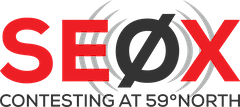SDR Fun in IARU HF Championship

I decided to play with technology and therefore entered in SO Unlimited. SE0X was wired up for semi-SO2R using the SunSDR2 PRO SDR transceiver as radio 1 plus a ColibriNANO SDR receiver as radio 2. Using the clever SDC utility from Yuri UT4LW allowed med to skim both receivers for spots and then combine these local spots with skimmer spots from our offsite skimmer. All spots where sent to N1MM and spots gathered by each radio where also displayed on that radio’s spectrum display.
Both radios had hardware controllers but as radio 2 couldn’t transmit ALT-F5 in N1MM was used to swap radios to be able to transmit on Radio 2’s frequency. Not the most elegant solution, but the second radio was useful for sweeping other bands for multipliers. A microHAM u2R was used for SO2R switching and 5B4AGN band pass filters kept the ColibriNANO’s RX reasonably free from interference.
A powerful feature of the small ColibriNANO is the automatic attenuator. At times the RF levels became overwhelming for this tiny direct sampling SDR. When this happened the automatic attenuator adjusted itself to an attenuation level so that clipping would be avoided.
I had planned to use a SPE 1.3-FA amplifier to be able to get full power with the low output drive level of the SunSDR2 PRO. For different reasons this plan failed, so I went to plan B using my old 1k-FA only able to produce about 500 watts on 20-10 meter and 700 watts on 40 and 80 meter with the 15 watt drive level from the transceiver.
Even if higher bands where not in their best shape, propagation was good enough to maintain action on 20 meter. 15 meter also provided contacts and multipliers and even 10 meter came to life with some DX including multipliers from zone 43 and 44. 40 meter was strong overnight with some NA stations peaking 20-30 dB over S9 which made the share of NA stations on 40 equal to the share on 20. 80 meter was also OK, but with less DX. Unfortunately, the 160 meter antenna was not available so a few multipliers was not within reach for me.
I operated quite casually spending some time to work Y8 WRTC stations and collect some of the DX mults. I took breaks for dinner and breakfast and even got 45 minutes of horizontal recharge overnight. The total calculated operating time was a bit over 22 hours.
I am quite happy with the result. The all-SDR setup worked very well but also spiked ideas for how to improve the ergonomic layout of the station when permamnetly replacing the K3/TS-590 combo with the SunSDR2 PRO radios. The claimed score is decent and breaks the record in the unlimited/assisted category, but it is about 300k short of SE0X’s 2014 record in the unassisted category.
| Band | QSOs | Pts | ITU | HQ | Pt/Q |
| 3,5 | 210 | 594 | 12 | 28 | 2,8 |
| 7 | 324 | 1008 | 20 | 42 | 3,1 |
| 14 | 562 | 1888 | 36 | 42 | 3,4 |
| 21 | 159 | 447 | 17 | 37 | 2,8 |
| 28 | 143 | 393 | 11 | 27 | 2,7 |
| Total | 1398 | 4330 | 96 | 176 | 3,1 |
| Total Claimed Score | 1 177 760 | ||||

2 Comments
SM0MDG
Hi Tom, your comment got lost in the busy pandemic times here. Feel free to ask any question you might still have and I will try to answer. You can contact me by email if you prefer, QRZ.com email is OK.
73 de SM0MDG
Tom
Hi,
very interesting article. I am trying to setup similar configuration with Station Master. But without success. Is it possible to discuss with you how to setup whole system?
73!
Tom